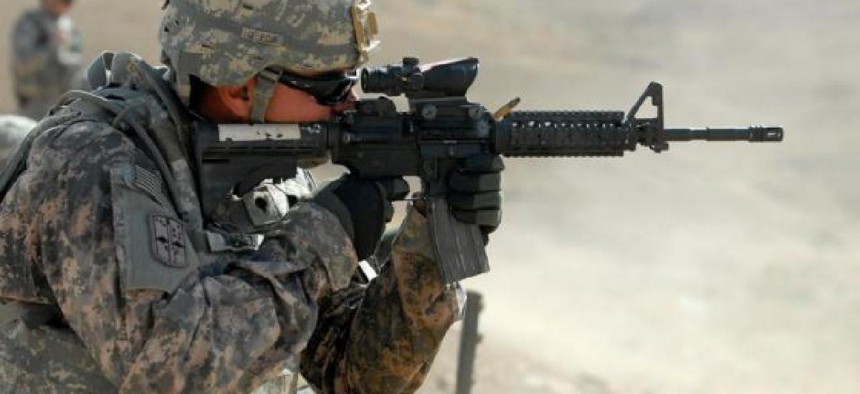Wireless technology connects rifle sights to night vision goggles
Soldiers will soon be able to locate and attack targets more quickly thanks to a wireless link connecting their rifles' thermal sights to night vision goggles.
Army soldiers tracking and attacking enemies in fast-moving combat situations will soon be able to shoot targets without bringing their rifle’s thermal sights up to their eyes -- thanks to wireless video interface connecting the sights to night-vision goggles, service officials said.
A wireless link will transmit the reticle from thermal weapons sights directly into the night vision goggle display, allowing soldiers the crosshairs through the thermal sights to without needing to actually move the weapon to their shoulder. The capability also eliminates the need for soldiers to rely on aiming lasers, so they are able to remain covert.
Enhanced targeting technology is of particular relevance in fast-developing battle circumstances, where targets can emerge and disappear in fractions of a second. Being able to strike quickly, therefore, can bring added lethality and mean the difference between life and death for soldiers.
The technology merges two separate Army developmental efforts. New, upgraded night vision goggles, called Enhanced Night Vision Goggle III (ENVG III), are combined with next-generation thermal weapons sights -- called Family of Weapons Sights-Individual (FWS-I), Army officials said.
“If you can imagine looking through a goggle and some target or threat presents itself, a soldier no longer has to come all the way up. He or she can put the bubble on the image and engage the target in that manner,” Lt. Col. Timothy Fuller, product manager, Soldier Maneuver Systems, said an interview last year.
The FWS-I thermal sight is mounted on top of an M-4 rifle. It can also be configured for crew-served weapons such as a .50-cal machine gun or sniper rifle, Army officials said.
“The thermal image you are seeing is wirelessly transmitted to the Enhanced Night Vision Goggle III and is displayed in its display. What you ultimately have is the crosshairs and a portion of the thermal weapon sights image spatially aligned to the image that the soldier sees in the night vision goggles,” FWS-I Assistant Product Manager Maj. Nicholas Breen said.
The Army’s ENVG III, which will begin formal production next summer, will provide soldiers with image-intensification, improved resolution and a wider thermal camera field-of-view compared to prior models.
“The night vision goggle takes two channels. This incorporates an image-intensification where you look through your goggle and are seeing a standard night vision goggle view and a thermal image all in one image. The two channels are on top of one another, and they are fused together so that you get all of the benefit of both channels,” Maj. Brandon Motte, Assistant Product Manager, Enhanced Night Vision, said.
The ENGV IIIs will also help with maneuverability and command and control by enabling soldiers to see a wider field of view with better resolution and even see infrared lasers, Motte added. The technology is now going through production qualification testing and will be operational in 2017.
“This greatly improves the lethality and visibility in all weather conditions for the soldier -- one very small, very lightweight night vision goggle,” Motte said.
The Army plans to acquire as many as 40,000 ENVG IIIs. ENVG III is being engineered to easily integrate FWS-I as soon as it is slated to be operational in 2018.
Defense contractors BAE Systems and DRS are involved in the developmental effort, Army officials said.
This story was also published by Scout Warrior .




